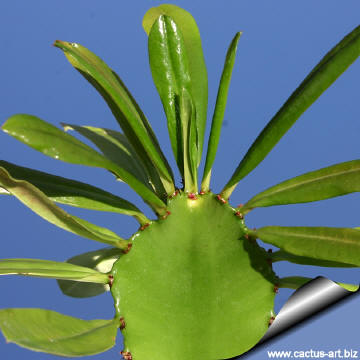|
|
|

Euphorbia
antiquorum
Euphorbia antiquorum is
the classic tree spurge of India.
|
|
Description: One of the
largest armed tree Euphorbias, cactus like in appearance with a rugged
elegance growing up to an height of 5 - 7 m, branched and rebranched to
form a loosely rounded crown, it has been known to attain gigantic
proportions if left undisturbed. A small population of giants was
discovered by a survey team from the Botanical Survey of India in a
secluded part of Kalakkad Reserve forest (alt. 800 m), reaching a height
of 20 m and a trunk of 1 m diameter.
Stems: 5-7 cm thick, green, glabrous, branching from upper parts;
upward curving, segmented. The odour of its latex is pungent and
lingering.
Ribs: 3 (or 4-5) prominent, winglike, up to 1-3 cm wide, 3-5 mm
thick, prominently triangular toothed., margins deeply sinuate.
Spines: Paired, sharp, 2-5 mm long, spine shields small, stipules
pricklelike.
Leaves: Few, borne on the ridges, succulent, quite insignificant
and fall off quickly, alternate, apically clustered, petiole very short,
leaf blade obovate, to oblanceolate to spathulate in shape 2-5(-10) ×
1-2 cm, base attenuate, margin entire. Apex rounded or obtuse with a
small pointed projection, base gradually narrowing downward. Leaves are
much more long in the young seedling.
Flowers: Cyathia yellowish-green to pinkish, subterminal,
axillary, single or in triads or 3-4 individual cyathia together;
peduncles reddish brown; primary peduncle 1 - 1.5 cm long, cyathia
peduncle 2-3 mm; all cyathia bisexual; anthers pinkish. Male flower with
only 1 stamen, filament short; female flower situated alone at the
center of the cyathium, protruding beyond the involucre. Styles 3, not
joined to each other, each style forking towards the tip. They are full
of honey that attract bees.
Blooming season: Flowers and fruitis all year.
Fruit: Capsules. Glabrous, obscurely lobed, smooth about 8-10 mm
in diameter. Green turning deep red on maturity.
Seeds: Globose, ca. 2 mm diameter brown-yellow, smooth.;
|
 |
 |
|
Advertising
|
|
|
|
|
|
|
Family: Euphorbiaceae
Accepted
scientific name: Euphorbia
antiquorum L.
Euphorbia antiquorum is the
type species for the genus Euphorbia it was described
by Linnaeus in 1753 in Species Plantarum, this Euphorbia, whose specific
name means 'of the ancients', was one of the two species
to be described from India.
Origin: Wide spread throughout peninsular India but wild
origin obscure. Escaped or naturalized and widely cultivated in
neighbouring regions such Burma, China, Bangladesh, India, Indonesia,
Iran, Malaysia, Myanmar, Pakistan, Philippines, Sri Lanka, Thailand,
Vietnam and world wide in many tropical zones.
Habitat :
Common English Names include:
Indian spurge
tree.
Habitat: Dry ever green forest., up to an
altitude of 800 m.
Conservation status: Listed in
CITES appendix 2.
|
|
|
|
Cultivation: It is an easy species to grow that is suited for any
well drained soil in full sun. It grows well when there is a layer of
brick and charcoal pieces, on top of which sandy loam soil is spread. It
needs no maintenance.. But young plant are happy growing indoors, where
they can easily reach the ceiling. Give the plant an airy growing medium
which mainly consists of non organic material such us clay, pumice, lava
grit, and only a little peat or leaf-mould. Water regularly during the
active growing season from March to September. No water should ever be
allowed to stand around the roots. Keep almost completely dry in winter.
It is a moderately fast grower, and will quickly become large landscape
masterpieces in just 3-5 years. Only downside is from strong winds, the
columns often smash into each other, causing permanent scarring... best
to plant in such a location where winds are not a big issue. If plant
becomes very red, this is a sign that the roots have not developed
properly. It is a relatively fast growing and long lived plant and once
established, it will be content in its position and with its soil for
years. It can tolerate moderate shade, and a plant that has been growing
in shade should be slowly hardened off before placing it in full sun as
the plant will be severely scorched if moved too suddenly from shade
into sun. Like quite small pots, repott in very later winter, early
spring. Can be pruned for shape and branching. Frost tender, klike all
Indian Euphorbias care should be taken to keep it warm in winter and
ensure a minimum temperature of 10° C. Plant Pests: Prone to
mealy bugs and rarely scale.
Propagation: It is
easy to propagate from seed or vegetatively in late spring to summer,
just take a cutting of the plant let it dry for 1 or 2 weeks and stuff
it in the ground (preferably dry, loose, extremely well draining soil).
Warning: All Euphorbias contain a white sap
that can be irritating to eyes and mucous membranes. If contact is made
with this white sap, take care to not touch face or eyes before washing
hands with soap and water.
USES:
- Ornamental: The plant is used in parks
and gardens for ornamentals and also for protective hedges, due to the
fragility of its branches together with the well known skin irritancy
of its latex. It can also be kept as an indoor ornamental plant.
- Traditional medicine: The milk is
intensely irritant, euphorbin is the major constituent of the latex.
Saline extracts of the stems are antibiotic. It is sometime taken as a
purgative, it is also used in rheumatism, toothache, nervine diseases,
dropsy, palsy, deafness, to kill maggots in wounds, to clear warts and
in contagious skin afflictions. The decoction of the stem is used in
gout.
- Food: Young shoots of the plant are used
as a vegetable.
- Fishing: The latex is a fish poison.

 |
|